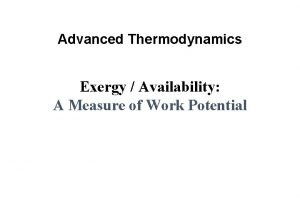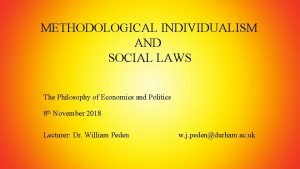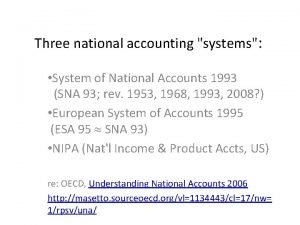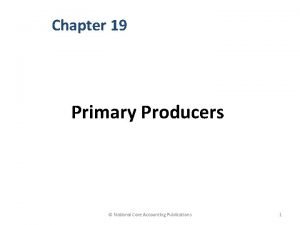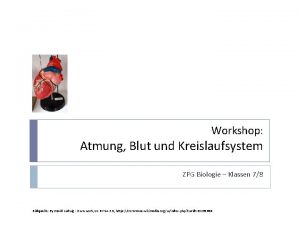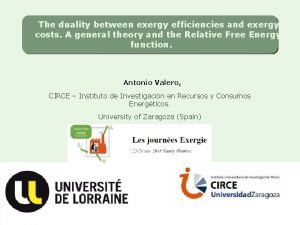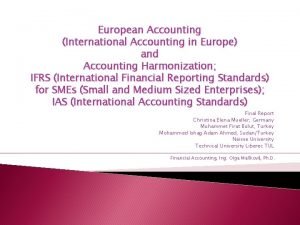Exergy Economics Workshop 2016 National Exergy Accounting Methodological

























![Category [6] Exergy Efficiency Calculation (x = mpg) Petrol road vehicles Proxy: 43. 75*(1 Category [6] Exergy Efficiency Calculation (x = mpg) Petrol road vehicles Proxy: 43. 75*(1](https://slidetodoc.com/presentation_image_h2/da78e0275bb60c19869659127fe32526/image-26.jpg)



- Slides: 29

Exergy Economics Workshop 2016 National Exergy Accounting: Methodological Developments and New Insights for Energy-Growth Decoupling Jack Miller Science Policy Research Unit (SPRU)

Ph. D Paper #1 “National exergy accounting: A quantitative comparison of methods and implications for analysis of energy economy interactions” • Exergy accounting method underpins exergy economics research. • Significant methodological developments sinception: → How consistent are successive studies? Main Category Heating Mechanical Drive Non-electrical light Electricity Sousa et. al. 2016 Muscle Work Sub-Category High temp. heat (600°C) Medium temp. heat 2 (200°C) Medium temp. heat 1 (100°C) Low temp. heat (20°C) Petrol road vehicles Diesel road vehicles Aviation engines Diesel boat engines Diesel trains Diesel tractors Biofuel road vehicles Coal locomotives Coal ship engines Industry static motors (diesel engines) Town gas lighting Energy sector own use Industry use Transport – rail Residential use Commercial / public sector use Other (e. g. agriculture) use Human work

Major developments Ayres & Warr (~2000+): Paul Brockway (2014+) Formalised allocation • Modified categories (REXS) model mapping of final exergy to • Efficiency: mechanical drive, • US (later UK, Austria, Japan) useful work • Energy data from disparate • IEA Energy Balances (1960+) sources • Portugal, EU-15 Primary → final → useful • Final → useful only • • Resource EXergy Services André Serrenho (2012+) • heat • More granular treatment of electricity

Ph. D Paper #1 “National exergy accounting: A quantitative comparison of methods and implications for analysis of energy economy interactions” Sousa et. al. (2016) “Improving the robustness of societal exergy accounting” • • Methodological review: Developments from 1970 s onwards Natural resource and energy carrier accounting In search of a quantitative view of methodological differences: 1. Form useful exergy model, UK, 1960 -2012. a) IEA Energy Balances b) “Base/alternative scenarios” – differing efficiency estimates. 2. Evaluate which methodological features are most significant for overall model outputs. 3. Suggestions for future methodologies.

Ph. D Paper #1 “National exergy accounting: A quantitative comparison of methods and implications for analysis of energy economy interactions” 1. Form useful exergy model, UK, 1960 -2012, using base/alternative scenarios. 2. Evaluate which methodological features are most significant for overall model outputs. 3. Suggestions for future methodologies. Primary or final? 20% Method of accounting for primary exergy of renewable and nuclear electricity? 10% 15% 5% 0% Primary-useful Final-useful 60 19 62 19 64 19 66 19 68 19 70 19 72 19 74 19 76 19 78 19 80 19 82 19 84 19 86 19 88 19 90 19 92 19 94 19 96 19 98 20 00 20 02 20 04 20 06 20 08 20 10 • Depends on desired outputs (national-level efficiency? Useful exergy? ) 19 • UK National Exergy Efficiency 25%

Ph. D Paper #1 “National exergy accounting: A quantitative comparison of methods and implications for analysis of energy economy interactions” 1. Form useful exergy model, UK, 1960 -2012, using base/alternative scenarios. 2. Evaluate which methodological features are most significant for overall model outputs. 3. Suggestions for future methodologies. Main Category Heating Categories of useful exergy? Mechanical Drive • Consideration: data availability for efficiencies • Different service temperatures for heating categories? • Missing categories (diesel trucks? ) • Superfluous categories? Non-electrical light Electricity Muscle Work Sub-Category High temp. heat (600°C) Medium temp. heat 2 (200°C) Medium temp. heat 1 (100°C) Low temp. heat (20°C) Petrol road vehicles Diesel road vehicles Aviation engines Diesel boat engines Diesel trains Diesel tractors Biofuel road vehicles Coal locomotives Coal ship engines Industry static motors (diesel engines) Town gas lighting Energy sector own use Industry use Transport – rail Residential use Commercial / public sector use Other (e. g. agriculture) use Human work

Efficiency estimation: Mechanical Drive categories Method 1: “Loss factors” method • Ideal Otto engine efficiency x real-world engine & drivetrain losses • Need: Data on average fleet engine compression ratio • Considers powertrain system only – useful exergy delivered “where rubber meets road” → Technical conversion device only Method 2: “mpg proxy” method • Average service efficiency (vehicle km/unit fuel) used as a proxy for exergy efficiency – whole vehicle design (aerodynamics etc). → Passive system incorporated • Uses real-world statistics on efficiency • Need: Data on vehicle mpg (petrol, diesel, aero, etc). Static motors?

Efficiency estimation: Mechanical Drive categories Method 1: “Loss factors” • Fleet average compression ratio, r • Sum product of loss factors αi ≈ 0. 17 Method 2: “mpg proxy” • Find average mpg data for petrol, diesel, etc • Use exergy efficiency estimates (Oak Ridge, Ayres etc) of vehicles • Use best fit procedure to generate formula for exergy efficiency based on vehicle mpg data for year t e. g. petrol: ε = 35. 0 [1 -exp(- 0. 025*xt)] xt = mpg in year t 35% 30% ε Efficiency, 25% 20% 15% 10% 5% 0% 0 50 mpg. US 100

Efficiency estimation: Mechanical Drive categories • Opposing differences in different mechanical drive categories act to cancel out overall difference • Petrol road vehicle responsible for majority of difference in total Petrol vehicles - exergy efficiency 25% 20% Mechanical Drive aggregate category useful exergy PJ 10% 350 5% 300 0% 250 200 mpg proxy Loss factors 1960 1962 1964 1966 1968 1970 1972 1974 1976 1978 1980 1982 1984 1986 1988 1990 1992 1994 1996 1998 2000 2002 2004 2006 2008 2010 2012 400 15% 150 100 Loss factors Total national final-useful exergy efficiency 24% 22% 20% 18% 16% 14% 12% 10% mpg proxy Loss factors 1960 1962 1964 1966 1968 1970 1972 1974 1976 1978 1980 1982 1984 1986 1988 1990 1992 1994 1996 1998 2000 2002 2004 2006 2008 2010 2012 0 mpg proxy 1960 1962 1964 1966 1968 1970 1972 1974 1976 1978 1980 1982 1984 1986 1988 1990 1992 1994 1996 1998 2000 2002 2004 2006 2008 2010 2012 50

Efficiency Estimation: Industrial (high-temperature) heat Method 1: Carnot method Method 2: “Ratio” method Exergy efficiency, ε “First-law” (energy) efficiency, ɳ Process temperature, Th Reference temperature, Tc Weighted average efficiency of steel & ammonia production as proxy for all high-temperature industrial uses. • Issues of ambiguity in ɳ • One process temperature for all HTH processes • More consistent with lower-temperature processes (also Carnot) • Uses tabulated industry statistics • How representative is steel/ammonia? Energy consumption per unit steel produced 40 GJ/ton 35 30 25 20 15 10 5 0 1960 1980 2000

Efficiency Estimation: Industrial (high-temperature) heat • Greatest single effect on national useful exergy output • UK: declining over period (1960 -2009) with deindustrialisation ε 25% HTH efficiency Total national final-useful exergy efficiency 20% 50% 45% 15% 40% 10% 35% 5% 0% 25% 20% Ratio Carnot (600 C) 1960 1962 1964 1966 1968 1970 1972 1974 1976 1978 1980 1982 1984 1986 1988 1990 1992 1994 1996 1998 2000 2002 2004 2006 2008 2010 2012 30% 15% 10% Steel proxy Carnot PJ 500 High-temperature heat useful exergy 400 300 200 100 0 Ratio Carnot (600 C) 1960 1962 1964 1966 1968 1970 1972 1974 1976 1978 1980 1982 1984 1986 1988 1990 1992 1994 1996 1998 2000 2002 2004 2006 2008 2010 2012 0% 1960 1962 1964 1966 1968 1970 1972 1974 1976 1978 1980 1982 1984 1986 1988 1990 1992 1994 1996 1998 2000 2002 2004 2006 2008 2010 2012 5%

Paper #1: Main conclusions & thoughts • Many differences in methodology to date – combined, can produce difference in u. e. output of ~20 -40% for UK • Generally, differences don’t make enormous difference: Mechanical drive and high-temperature heat most significant • MD: Technical conversion device (engine) or passive system (whole vehicle)? • HTH: 2 definitions of exergy efficiency • What’s “best”? • Cross-country comparability? • Data availability? • Data issues: • Inadequate disaggregation • Cross-country (in)consistency • Electricity: • Tricky to define exergy efficiency • Data availability (efficiency of computers? )

Next steps… Papers 2 -3 / overarching goals 1. Using outcome of #1, update/form new useful exergy datasets. 2. Econometric analysis: Economic output, useful exergy, primary/final energy, capital, labour (quality adjustment? ) a) Cointegration b) Granger causality 3. Useful exergy vs. primary/final energy: 1. Which predicts growth better? 2. Primary energy intensity vs useful exergy intensity?

Jack Miller Doctoral Research Student Sussex Energy Group Centre on Innovation & Energy Demand Science Policy Research Unit (SPRU) University of Sussex j. miller@sussex. ac. uk

Supplementary Slides

0% 4, 50% 4, 00% Base 30% Base Al 1 Alt 1 25% 3, 50% 3, 00% 2, 50% 2, 00% 1, 50% 1, 00% 0, 50% MTH 2 25% 20% 15% 10% Alt 2 0% 10% 5% 0% 1960 1962 1964 1966 1968 1970 1972 1974 1976 1978 1980 1982 1984 1986 1988 1990 1992 1994 1996 1998 2000 2002 2004 2006 2008 2010 2012 LTH 1960 1962 1964 1966 1968 1970 1972 1974 1976 1978 1980 1982 1984 1986 1988 1990 1992 1994 1996 1998 2000 2002 2004 2006 2008 2010 2012 5% 1960 1962 1964 1966 1968 1970 1972 1974 1976 1978 1980 1982 1984 1986 1988 1990 1992 1994 1996 1998 2000 2002 2004 2006 2008 2010 2012 0, 00% 1960 1962 1964 1966 1968 1970 1972 1974 1976 1978 1980 1982 1984 1986 1988 1990 1992 1994 1996 1998 2000 2002 2004 2006 2008 2010 2012 5, 00% 30% MTH 1 Base 50% Base Alt 1 Alt 2 20% 15% 10% 5% HTH 45% 40% 35% 30% 25% 20% 15% Alt 2

Production Imports Exports Total Primary Energy International marine bunkers * International aviation bunkers * Supply Stock changes Transfers Statistical differences Main activity producer electricity plants Autoproducer electricity plants Main activity producer CHP plants Autoproducer CHP plants Main activity producer heat plants Autoproducer heat plants Heat pumps Electric boilers Chemical heat for electricity production Blast furnaces (TBLASTFUR) Transformation Gas works (TGASWKS) Processes Coke ovens (TCOKEOVS) Patent fuel plants (TPATFUEL) BKB/peat briquette plants (TBKB) Oil refineries (TREFINER) Petrochemical plants Coal liquefaction plants (TCOALLIQ) Gas-to-liquids (GTL) plants (TGTL) For blended natural gas Charcoal production plants (TCHARCOAL) Non-specified (transformation) Electricity output (GWh)-main activity producer electricity plants Electricity output (GWh)-autoproducer Electricity Output electricity plants (GWh) Electricity output (GWh)-main activity producer CHP plants Electricity output (GWh)-autoproducer CHP plants Heat output-main activity producer CHP plants Heat output-autoproducer CHP plants Heat Output Heat output-main activity producer heat plants Heat output-autoproducer heat plants Industry Coal mines Iron and steel Oil and gas extraction Chemical and petrochemical Non-ferrous metals Blast furnaces Non-metallic minerals Transport equipment Gas works Industry Gasification plants for biogases Paper, pulp and print Wood and wood products Patent fuel plants Construction BKB/peat briquette plants Textile and leather Non-specified (industry) Oil refineries Coal liquefaction plants Liquefaction (LNG) / regasification plants Domestic aviation Total Final Consumption Road Rail Transport Non-specified (transport) Other Own use in electricity, CHP and heat plants Nuclear industry Charcoal production plants Residential Commercial and public services Agriculture/forestry ‘Other’ Fishing Non-specified (other) Non-energy use industry/transformation/energy Non-specified (energy) Losses Pipeline transport Domestic (marine) navigation Gas-to-liquids (GTL) plants Pumped storage plants Mining and quarrying Food and tobacco Coke ovens Energy Industry Own Use Machinery Non-energy use Memo- Non-energy use chemical/petrochemical Non-energy use in transport Non-energy use in other

Hard coal (if no detail) Brown coal (if no detail) Anthracite Coking coal Other bituminous coal Sub-bituminous coal Lignite Peat Patent fuel Coke oven coke Gas coke Coal tar BKB Gas works gas Coke oven gas Blast furnace gas Other recovered gases Elec/heat output from nonspecified manufactured gases Industrial waste Municipal waste (renewable) Municipal waste (non-renewable) Primary solid biofuels Biogases Biogasoline Biodiesels Other liquid biofuels Non-specified primary biofuels and waste Charcoal Natural gas Crude/NGL/feedstocks (if no detail) Crude oil Natural gas liquids Refinery feedstocks Additives/blending components Other hydrocarbons Refinery gas Ethane Liquefied petroleum gases (LPG) Motor gasoline excl. biofuels Aviation gasoline Gasoline type jet fuel Kerosene type jet fuel excl. biofuels Other kerosene Gas/diesel oil excl. biofuels Fuel oil Naphtha White spirit & SBP Lubricants Bitumen Paraffin waxes Petroleum coke Other oil products Heat output from non-specified combustible fuels Nuclear Hydro Geothermal Solar photovoltaics Solar thermal Tide, wave and ocean Wind Other sources Electricity Heat Total Renewables (total) Oil shale and oil sands Peat products • Coal, coal products and peat • Combustible renewables • Natural Gas • Oil & oil products • Direct heat • Electricity & renewables • Totals

Allocation “Flow” (sector) ↓ “Product” (energy carrier) ↓ Useful exergy category (~3000 allocations!)

General Approach to National Exergy Accounting 1. Collect primary/final energy data (IEA, REXS etc. ) Categories of useful exergy Aggregate category 2. Convert energy to exergy values 3. Allocate to categories of useful exergy Heating 4. Apply exergy efficiencies to each category → useful exergy 5. Aggregate inputs (primary/final ex. ) and outputs (useful ex. ) → National efficiency Mechanical Drive PJ Primary Exergy, by aggregate category 10000 8000 6000 Non-electrical lighting 4000 Electrical use 2000 0 19 60 64 19 68 19 Heat 72 19 76 19 80 19 84 19 88 19 Mechanical Drive 92 19 96 19 00 20 04 20 Electricity Inputs 08 20 12 20 Muscle work Disaggregate category High-temp. industrial heat Low-temp. industrial heat Water heating Space heating Petrol road vehicle Diesel car Diesel truck Aviation Diesel shipping Diesel rail Electric rail Coal rail Diesel static motor Town gas lighting Industrial use Residential use Commercial/public sector use Other use Human muscle work

First-law efficiency 90% 85% 80% 75% 70% 65% 60% 55% 50% 45% Base scenario (LTH, MTH 1) Alt scenario 1 (LTH) Alt scenario 2 (MTH 1) 70 19 72 19 74 19 76 19 78 19 80 19 82 19 84 19 86 19 88 19 90 19 92 19 94 19 96 19 98 20 00 20 02 20 04 20 06 20 08 68 19 66 19 64 19 62 19 19 19 60 40%

35% 0% Base Alt 1 30% 15% 10% 5% Aero 40% 35% 25% 30% 25% 0% Base 12 20 08 20 04 20 00 20 96 19 mpg proxy 92 19 88 19 84 19 80 5% 19 10% 76 10% 19 Petrol vehicles - exergy efficiency 72 15% 19 15% 68 20% 19 20% 64 25% 19 Loss factors 60 mpg proxy 19 25% 1960 1962 1964 1966 1968 1970 1972 1974 1976 1978 1980 1982 1984 1986 1988 1990 1992 1994 1996 1998 2000 2002 2004 2006 2008 2010 2012 0% 1960 1962 1964 1966 1968 1970 1972 1974 1976 1978 1980 1982 1984 1986 1988 1990 1992 1994 1996 1998 2000 2002 2004 2006 2008 2010 2012 5% 1960 1962 1964 1966 1968 1970 1972 1974 1976 1978 1980 1982 1984 1986 1988 1990 1992 1994 1996 1998 2000 2002 2004 2006 2008 2010 2012 Mechanical Drive main efficiencies Diesel vehicles - exergy efficiency Loss factors 0% Diesel Trains Alt 1 20% 15% 10% 5%

15% Differences in category useful exergy outputs, as percentages of base scenario total mechanical drive useful exergy 10% 5% 60 19 62 19 64 19 66 19 68 19 70 19 72 19 74 19 76 19 78 19 80 19 82 19 84 19 86 19 88 19 90 19 92 19 94 19 96 19 98 20 00 20 02 20 04 20 06 20 08 0% 19 -5% -10% -15% -20% -25% -30% Diesel road vehicles Aviation Petrol road vehicles Diesel shipping Diesel static motors Diesel trains Difference in useful exergy output between base (proxy method) and alternative (loss factors method) scenarios of each mechanical drive category, divided by the total useful exergy output of the base scenario, expressed as a percentage.

Mton 40 30, 0 35 25, 0 30 20, 0 25 20 15, 0 15 10, 0 10 5, 0 5 0, 0 1970 1980 1990 2000 2010 Ratio method exergy efficiency 45, 00% 40, 00% 35, 00% 30, 00% 25, 00% 20, 00% 15, 00% 10, 00% 5, 00% 0, 00% EAF BOF + OHF Theoretical minimum: EAF: 1. 3 GJ/ton BOF: 8. 6 GJ/ton 1960 1963 1966 1969 1972 1975 1978 1981 1984 1987 1990 1993 1996 1999 2002 2005 2008 2011 0 1960 UK steel produced 1960 1962 1964 1966 1968 1970 1972 1974 1976 1978 1980 1982 1984 1986 1988 1990 1992 1994 1996 1998 2000 2002 2004 2006 2008 2010 2012 GJ/ton Energy consumption per unit steel produced

Electricity final/useful exergy Electricity final exergy, by sector PJ 200 450 180 400 160 350 140 300 120 250 100 200 80 150 60 100 40 50 20 0 0 1 3 5 7 9 11131517192123252729313335373941434547495153 Energy sector Industry Rail Electricity useful exergy, by sector 1960 1962 1964 1966 1968 1970 1972 1974 1976 1978 1980 1982 1984 1986 1988 1990 1992 1994 1996 1998 2000 2002 2004 2006 2008 2010 2012 PJ 500 Energy sector Industry Rail Residential Commercial/public Other
![Category 6 Exergy Efficiency Calculation x mpg Petrol road vehicles Proxy 43 751 Category [6] Exergy Efficiency Calculation (x = mpg) Petrol road vehicles Proxy: 43. 75*(1](https://slidetodoc.com/presentation_image_h2/da78e0275bb60c19869659127fe32526/image-26.jpg)
Category [6] Exergy Efficiency Calculation (x = mpg) Petrol road vehicles Proxy: 43. 75*(1 -e -0. 025 x) Diesel road vehicles Proxy: 35*(1 -e-0. 025 x) Aviation Proxy: 50*(1 -e-2. 25 x) Diesel shipping Diesel trains Category [21] Exergy Efficiency Calculation Gasoline/LPG vehicles Loss-factor: time series of compression ratios and equations 2. 1 and 2. 2. Diesel vehicles 125% of gasoline vehicles Aviation Linear 14 -% over period, adapted from [22] Diesel shipping Linear 32 -40% over period, adapted from [22] Natural gas vehicles 8% throughout Diesel-electric trains 24 -35% [34] Steam locomotives 6. 4 -6. 6% 1960 -1968, constant thereafter (from literature) Equal to diesel trains Proxy: 50*(1 -e-0. 065 x) Diesel tractors 50% of diesel road vehicles Biofuel road vehicles Average of diesel and gasoline road vehicles Steam locomotives 17% of diesel trains Coal ships Equal to steam locomotives Oil stationary motors Equal to diesel shipping Industry static motors (diesel engines) Linear 25 -30% over period [25] Coal stationary motors Equal to diesel shipping

Category Base scenario Alternative scenario 1 Alternative scenario 2 HTH (600°C) ‘Ratio’ method: Theoretical minimum / actual exergy used for steel and ammonia industries Carnot method, with Th = 500°C Carnot method, with Th = 600°C Carnot method, with Th = 150°C Carnot method, with Th = 200°C MTH 2 (200°C)

Category LTH (Lowest temperature category) MTH 1 (Low/medium temperature category) Parameter value (base scenario) Parameter value (alternative scenario 1) Parameter value (alternative scenario 2) First-law efficiency, ɳ 51 -86% over period (see figure 3. 13) 49 -57% over period (see figure 3. 13) As in base scenario ‘Cold reservoir’ temperature, Tc UK average Winter outdoor UK temperature (time series) As in base scenario ‘Hot reservoir’ temperature, Th UK average domestic indoor temperature (time series) As in base scenario 50°C First-law efficiency 51 -86% over period (see figure 3. 13) 58 -71% over period (see figure 3. 13) As in base scenario ‘Cold reservoir’ temperature, Tc UK average annual outdoor temperature (time series) As in base scenario ‘Hot reservoir’ temperature, Th 100°C As in base scenario 120°C

Brockway et al. , 2014 (Supp. Inf. )
 Exergy formula
Exergy formula Methodological integrity
Methodological integrity Methodological triangulation
Methodological triangulation Methodological individualism weber
Methodological individualism weber Methodological behaviorism
Methodological behaviorism Methodological background
Methodological background Methodological behaviourism
Methodological behaviourism Maastricht university school of business and economics
Maastricht university school of business and economics Econ213
Econ213 2016 national patient safety goals
2016 national patient safety goals National curriculum framework grade 7-9
National curriculum framework grade 7-9 National disaster recovery framework 2016
National disaster recovery framework 2016 2016 national curriculum tests
2016 national curriculum tests Financial accounting and accounting standards chapter 1
Financial accounting and accounting standards chapter 1 Traditional accounting vs computerized accounting
Traditional accounting vs computerized accounting Going concern assumption
Going concern assumption Role and responsibility of management accountant ppt
Role and responsibility of management accountant ppt What is system of national accounts
What is system of national accounts Macroeconomics examples
Macroeconomics examples Produksyon at kita ng pambansang ekonomiya
Produksyon at kita ng pambansang ekonomiya What is national accounting
What is national accounting Real gdp per capita formula
Real gdp per capita formula National panchayat accounting manual
National panchayat accounting manual National income accounting equation
National income accounting equation National core accounting publications
National core accounting publications National unification and the national state
National unification and the national state Xxxxxx 2017
Xxxxxx 2017 Zpg biologie
Zpg biologie Accuwage 2016
Accuwage 2016 Vdoe geometry standards 2016
Vdoe geometry standards 2016
